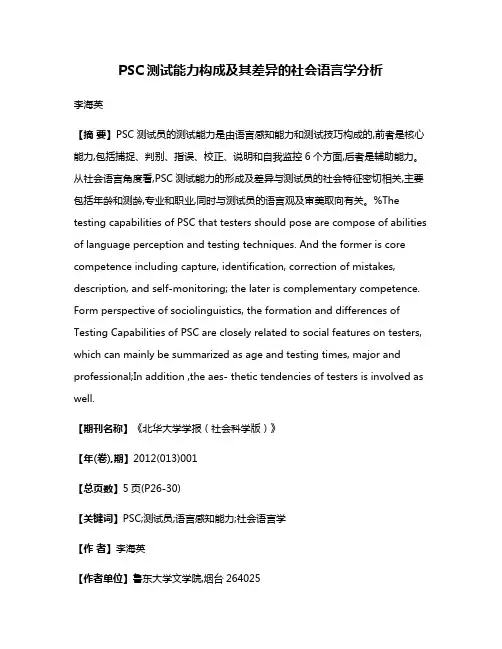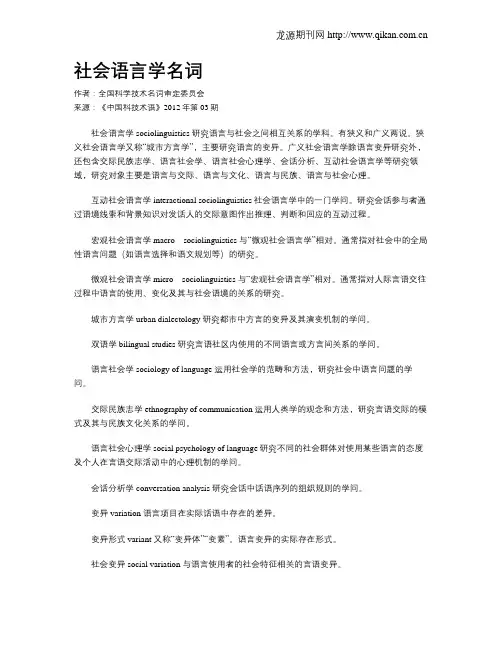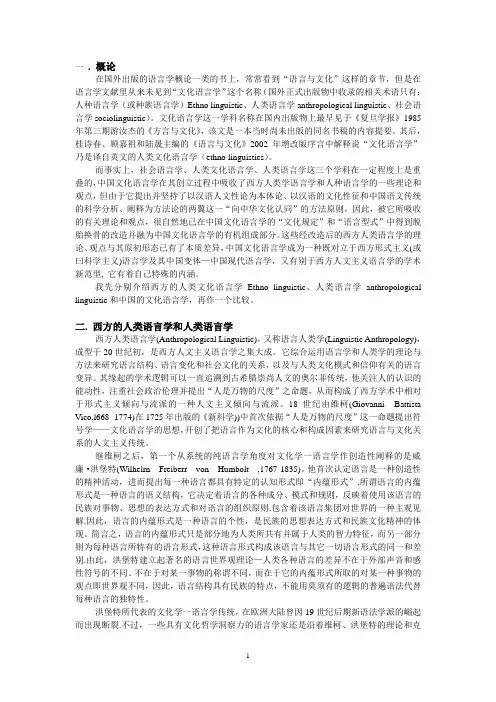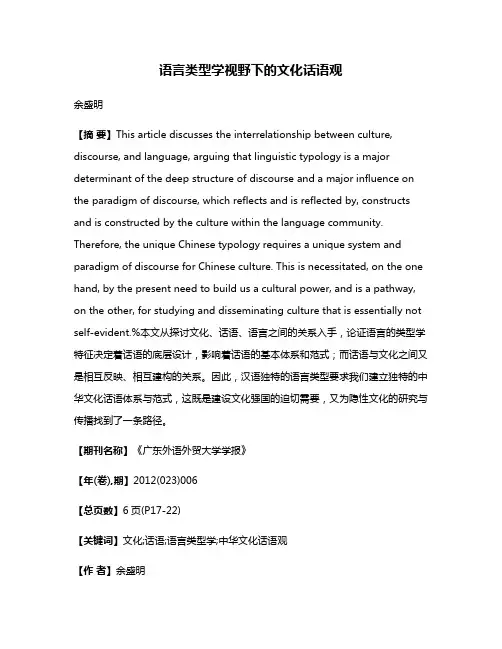The Ethnography of Communication 言语交际民俗学
名词解释

According to "The Canadian Modern Language Review", formulaic sequences are "fixed combinations of words that...can facilitate fluency in speech by making pauses shorter and less frequent, and allowing longer runs of speech between pauses".[1]
the comparative of many disyllabic adjectives can be formed either with the word more or with the suffix -er, for example more stupid or stupider
目前DJ音标符号共计有48个,其中元音有20个﹔辅音有28个。
DJ音标初期可能是为了节省印刷模具数量,只有11个符号不同于英文字母;后来发明者的学生为了一符一音,变为有15个符号不同于英文字母。
The Prague school, or Prague linguistic circle,[1] was an influential[2] group of literary critics and linguists in Prague. Its proponents developed methods of structuralist literary analysis[3] and a theory of the standard language and of language cultivation during the years 1928–1939. The linguistic circle was founded in the Café Derby in Prague, which is also where meetings took place during its first years.[4]
PSC测试能力构成及其差异的社会语言学分析

PSC测试能力构成及其差异的社会语言学分析李海英【摘要】PSC测试员的测试能力是由语言感知能力和测试技巧构成的,前者是核心能力,包括捕捉、判别、指误、校正、说明和自我监控6个方面,后者是辅助能力。
从社会语言角度看,PSC测试能力的形成及差异与测试员的社会特征密切相关,主要包括年龄和测龄,专业和职业,同时与测试员的语言观及审美取向有关。
%The testing capabilities of PSC that testers should pose are compose of abilities of language perception and testing techniques. And the former is core competence including capture, identification, correction of mistakes, description, and self-monitoring; the later is complementary competence. Form perspective of sociolinguistics, the formation and differences of Testing Capabilities of PSC are closely related to social features on testers, which can mainly be summarized as age and testing times, major and professional;In addition ,the aes- thetic tendencies of testers is involved as well.【期刊名称】《北华大学学报(社会科学版)》【年(卷),期】2012(013)001【总页数】5页(P26-30)【关键词】PSC;测试员;语言感知能力;社会语言学【作者】李海英【作者单位】鲁东大学文学院,烟台264025【正文语种】中文【中图分类】H102测试员之间的信度差异、测试能力差异是客观存在的。
社会语言学名词

社会语言学名词作者:全国科学技术名词审定委员会来源:《中国科技术语》2012年第03期社会语言学 sociolinguistics 研究语言与社会之间相互关系的学科。
有狭义和广义两说。
狭义社会语言学又称“城市方言学”,主要研究语言的变异。
广义社会语言学除语言变异研究外,还包含交际民族志学、语言社会学、语言社会心理学、会话分析、互动社会语言学等研究领域,研究对象主要是语言与交际、语言与文化、语言与民族、语言与社会心理。
互动社会语言学 interactional sociolinguistics社会语言学中的一门学问。
研究会话参与者通过语境线索和背景知识对发话人的交际意图作出推理、判断和回应的互动过程。
宏观社会语言学 macro sociolinguistics 与“微观社会语言学”相对。
通常指对社会中的全局性语言问题(如语言选择和语文规划等)的研究。
微观社会语言学 micro sociolinguistics 与“宏观社会语言学”相对。
通常指对人际言语交往过程中语言的使用、变化及其与社会语境的关系的研究。
城市方言学 urban dialectology 研究都市中方言的变异及其演变机制的学问。
双语学 bilingual studies 研究言语社区内使用的不同语言或方言间关系的学问。
语言社会学 sociology of language 运用社会学的范畴和方法,研究社会中语言问题的学问。
交际民族志学 ethnography of communication运用人类学的观念和方法,研究言语交际的模式及其与民族文化关系的学问。
语言社会心理学 social psychology of language研究不同的社会群体对使用某些语言的态度及个人在言语交际活动中的心理机制的学问。
会话分析学 conversation analysis 研究会话中话语序列的组织规则的学问。
变异 variation 语言项目在实际话语中存在的差异。
理查德·鲍曼及其表演理论1

理查德·鲍曼及其表演理论1——美国民俗学者系列访谈之⼀杨利慧安德明我们于2000年8⽉~2001年8⽉在美国访学期间,曾经有计划地对10位当代美国民俗学界有影响的学者进⾏了系列访谈,其中包括理查德·鲍曼(Richard Bauman)、阿兰·邓迪斯(Alan Dundes)、亨利·格莱西(Henry Glassie)、琳达·戴格(Linda Degh)等,访谈的内容⼴泛涉及当代国际民俗学的理论与⽅法、民俗学发展的新视野、民俗学在未来的兴衰、民俗学与⼈类学的联系与区别、民俗学者的⼈⽣旨趣与⼈⽂关怀,等等。
理查德·鲍曼(Richard Bauman)是当代美国著名的民俗学家、⼈类学家,表演理论(Performance Theory)的主要代表⼈物之⼀,现于美国印第安纳⼤学民俗学与⾳乐⽂化学系、传媒学系(Department of Communication)任教,为印⼤“杰出教授”(Distinguished Professor)。
他的表演理论在民俗学、⼈类学、⽂学、语⾔学、教育学、历史学、交流与传媒等许多学科领域⾥都产⽣了巨⼤影响。
我们在印⼤访学期间,听过鲍曼的课,并对他进⾏了数次采访,就其表演理论的形成、主要主张、理论贡献及有关批评等问题,进⾏了深⼊的访谈与交流,获益⾮浅。
现征得他的同意,我们把这些访谈内容整理出来,以求裨益于⼴⼤的国内读者。
我们分别在鲍曼就职的民俗学系和传媒学系的办公室⾥对他进⾏了采访。
鲍曼坐在椅⼦上,⼤眼镜后⾯时时射出敏锐的、具有穿透⼒的⽬光。
每当我们问他⼀个问题,他会在⽚刻的沉思之后,马上滔滔不绝、旁征博引地说上好半天,仿佛整个西⽅学术的发展脉络都装在他那智慧的⼤脑袋⾥。
安德明(以下简称安):从⼤学到博⼠阶段,你所学的专业都不相同,我们注意到,这些专业在你的研究中都有所表现,或者说,你的研究中似乎融合了⼏个专业的特征,是不是这样呢?鲍曼:我的确想要把⽂学、美国研究(American Studies)和民俗学⼏门学科结合起来。
人类文化语言学

一. 概论在国外出版的语言学概论一类的书上,常常看到“语言与文化”这样的章节,但是在语言学文献里从来未见到“文化语言学”这个名称(国外正式出版物中收录的相关术语只有:人种语言学(或种族语言学)Ethno linguistic、人类语言学anthropological linguistic、社会语言学sociolinguistic)。
文化语言学这一学科名称在国内出版物上最早见于《复旦学报》1985年第三期游汝杰的《方言与文化》,该文是一本当时尚未出版的同名书稿的内容提要。
其后,桂诗春、顾嘉祖和陆晟主编的《语言与文化》2002年增改版序言中解释说“文化语言学”乃是译自英文的人类文化语言学(ethno linguistics)。
而事实上,社会语言学、人类文化语言学、人类语言学这三个学科在一定程度上是重叠的,中国文化语言学在其创立过程中吸收了西方人类学语言学和人种语言学的一些理论和观点,但由于它提出并坚持了以汉语人文性论为本体论、以汉语的文化性征和中国语文传统的科学分析、阐释为方法论的两翼这一“向中华文化认同”的方法原则,因此,被它所吸收的有关理论和观点,很自然地已在中国文化语言学的“文化规定”和“语言型式”中得到脱胎换骨的改造并融为中国文化语言学的有机组成部分。
这些经改造后的西方人类语言学的理论、观点与其原初形态已有了本质差异,中国文化语言学成为一种既对立于西方形式主义(或曰科学主义)语言学及其中国变体—中国现代语言学,又有别于西方人文主义语言学的学术新范型, 它有着自己特殊的内涵。
我先分别介绍西方的人类文化语言学Ethno linguistic、人类语言学anthropological linguistic和中国的文化语言学,再作一个比较。
二. 西方的人类语言学和人类语言学西方人类语言学(Anthropological Linguistic),又称语言人类学(Linguistic Anthropology),成型于20世纪初,是西方人文主义语言学之集大成。
语言类型学视野下的文化话语观

语言类型学视野下的文化话语观余盛明【摘要】This article discusses the interrelationship between culture, discourse, and language, arguing that linguistic typology is a major determinant of the deep structure of discourse and a major influence on the paradigm of discourse, which reflects and is reflected by, constructs and is constructed by the culture within the language community. Therefore, the unique Chinese typology requires a unique system and paradigm of discourse for Chinese culture. This is necessitated, on the one hand, by the present need to build us a cultural power, and is a pathway, on the other, for studying and disseminating culture that is essentially not self-evident.%本文从探讨文化、话语、语言之间的关系入手,论证语言的类型学特征决定着话语的底层设计,影响着话语的基本体系和范式;而话语与文化之间又是相互反映、相互建构的关系。
因此,汉语独特的语言类型要求我们建立独特的中华文化话语体系与范式,这既是建设文化强国的迫切需要,又为隐性文化的研究与传播找到了一条路径。
大学思辨英语教程 精读1Unit 3教师用书
Unit 3 Verbaland Non-verbal CommunicationUnit overviewBoth Units 1 and 2 mention a key word “communication”.As Thomas Payne points out in Text B of Unit 2, most of us, linguists or non-linguists, have the common-sense notion that “the main purpose of human language is communication”. Thus to develop a deeper understanding of the nature and function of language, we need to take a close at human communication. This unit examines this topic from a cross-cultural perspective, illustrating the similarities and differences in verbal and non-verbal communication between different cultures, which lays a foundation for further exploration into the interface between language and culture in the following units.Text APeople in different communities demonstrate different perceptions and rules of both verbal and non-verbal communication. The way they interact is culturally relative in almost every aspect, including when to talk, what to say, pacing and pausing, listenership, intonation and prosody, formulaicity, indirectness, and coherence and cohesion.Text BSome non-verbal behaviors are practically universal and have the same meaning wherever you are ., smiling and facial expressions of anger, surprise, fear, sadness, and so on). But for cultural and historical reasons, there have also developed great differences and variations in such aspects as eye contact, touch, gestures, and territorial space, etc. Without an awareness of respect and accommodation for people from a different background, these differences are likely to cause misunderstandings in cross-cultural communication.The two texts supplement each other in that Text A illustrates cross-cultural differences in both verbal and non-verbal communication while Text B focuses on non-verbal behaviors and addressesbothdifferences and similarities.Teaching objectivesThis unit is designed to help students develop their reading skills, communicative competence, critical thinking, intercultural reflection and abilities of autonomous learning in the following aspects.Reading skills:Use context to understand a new wordIdentify cohesive devicesPredict the content of an upcoming sentence/paragraphCommunicative competence:Develop a coherent and cohesive oral/written discourseUse topic sentences, supporting sentences and concluding sentences in presentations/essaysCommunicate constructively in team workCritical thinking:Evaluate the strengths and weaknesses of personal experience as evidence in argumentationOrganize the arguments using an outlineNote and reflect on the differences between academic writing and everyday writingIntercultural reflectionIdentify similarities and differences in non-verbal communication across culturesBe aware of multiple levels of differences on which cross-cultural communication can falterInterpret communication behaviors from cultural and historical perspectivesTeaching strategiesNon-verbal communication and cross-cultural communication are both interesting topics in linguistics. The teacher can introduce the two texts by quoting anecdotes or relating to students’own experiences(question 5 in Preparatory work, p. 59). For students who lack experience of cross-cultural communication, the topic can be led in by discussions about inter-subcultural communication.Text A is a research articlefrom an academic journaland its structure and writing style are quite clear. It is recommended to draw students’ attention to the author’s logic ., ways of arguing) and use of evidence in class. If well-planned, all the questions in Preparatory Work and Critical reading can be dealt with in some detail in class. The teacher can follow all the questions in Understanding the text to check students’ comprehension of the text, while the tasks in Evaluation and exploration can be divided and assigned to groups. For example, in Making an outline (p. 62), the teacher can divide the students into three groups, each responsible for one topic.For classical works in intercultural communication, please refer to:Hall, Edward T. (1955). The Anthropology of American,192: 85-89. Hall, Edward T. (1959). The Silent Language. New York: Doubleday.For more updated information, please find the following journals:Cross-Cultural Communication published by Canadian Academy ofOriental and Occidental Culture (CAOOC)Across Languages and Cultures published by AkadémiaiKiadóLanguage and Intercultural Communication published byRoutledge Journals, Taylor & Francis Ltd.Preparatory work(1)Academic interests: gender and language, interactionalsociolinguistics, conversational interaction, cross-cultural communication, frames theory, conversational vs. literary discourse, and new media discourse.Main publications:You Just Don't Understand: Women and Men in Conversation. New York: Morrow, 1990.That's Not What I Meant!: How Conversational Style Makes or Breaks Relationships. NY: William Morrow, 1986.Gender and Discourse. NY & Oxford: Oxford University Press, 1994.Note: Outside the academic world Deborah Tannen is best known as the author of a number of books on the New York Times best seller and she is also a frequent guest on television and radio news and information shows.(2)Edward Sapir (1884–1939): an American anthropologist who is widely regarded as one of the most important figures in the early development of modern linguistics. His main interests are in the ways in which language and culture influence each other, the relation between linguistic differences, and differences in cultural world views. His most important contribution is what is known as the principle of linguistic relativity or the "Sapir-Whorf" hypothesis.John Joseph Gumperz(1922 –2013): an American linguist. His research interests include the languages of India, code-switching, and conversational interaction. Well-known for his contribution in interactional sociolinguistics and the "ethnography of communication", Gumperz’s research has benefitted such fields as sociolinguistics, discourse analysis, and linguistic anthropology.E. M. Forster (1879 –1970): an English novelist, short story writer, essayist and librettist. He is known best for his ironic and well-plotted novels examining class difference and hypocrisy in early 20th-century British society. He was nominated for the Nobel Prize in Literature in 13 different years.Robert Kaplan:An American applied linguist. His research area covers applied linguistics, discourse analysis, language policy, language planning, and ESL/EFL Teaching. He is most famous for his contribution in Contrastive Rhetoric, a term he first coined in 1966. Kaplan has authored or edited 32 books, more than 130 articles in scholarly journals and chapters in books, and more than 85 book reviews and other ephemeral pieces in various newsletters, as well as 9 special reports to the . government and to governments elsewhere.(3) is the systematic study of meaning dependent on language in use. Unlike semantics, which examines conventional meaning "coded" in a given language, pragmatics studies how the transmission of meaning depends not only on structural and linguistic knowledge ., grammar, lexicon, etc.) of the speaker and the hearer, but also on the context of the utterance, any pre-existing knowledge about those participants involved, the inferred intent of the speaker, and other factors. Central topics of p ragmatics include a speaker’s communicative intentions, the use of language that requires such intentions, context of use, the relation between the user of a linguistic form and the act of using the form, and the strategies an addressee employs to work out what the intentions and acts are.(4)Cohesion refers to the use of various phonological, grammatical, and/or lexical means to link sentences or utterances into a well-connected, larger linguistic unit such as a paragraph or a chapter. In other words, cohesion achieves well-connectedness by means of linguistic forms.Example: Mary is a secretary. She works in a law firm. Yan (2012)Coherence refers to the logical well-connectedness between different parts of a piece of spoken or written language, which distinguishes it from a random assemblage of sentences or utterances. Yan (2012)Formly incohesive discourse may be coherent through common se nse, cultural background, contextual information, imagination, logical assumption, etc.Husband: That’s the telephone.Wife: I’m in the bath.Husband: OK.(5)Pause is a temporary and brief break in the flow of speech, which is often classified into filled pause and unfilled or silent pause. The former is taken up or filled by a hesitation form like ah, er,and um. In contrast, the latter is not filled by a hesitation form. In other words, a silent pause is one where there is no vocalization.Critical readingI. Understanding the text(1) The main purpose of this article is to illustrate eight levels of cross-cultural differences in non-verbal aspects of communication.(2) We can understand the nature of language by observing it in communication and in contact with other systems of communication.(3) Pacing and pausing, listenership. In deciding when to talk and what to say, the speaker usually takes a conscious speech planning, yet in pacing and pausing and in showing listenership in a conversation, one does not need to stop and think for a decision.(4) Section starts with a direct thesis statement. Then the author explains it with an expert’s (Scollon) research findings and section the author raises a number of questions (in para 7, 9 and 11) and responds to them with relevant research findings (Goody’s as well as hers) and her own personal experience. Section is also organized in the order of “question-answer”. Section illustrates cross-cultural differences in listenership with two examples, gaze (paras 21 and 22) and loud responses (para 23), and then moves on to the conclusion (para 24). Section : example-discussion. Section : personal experience and a very brief interpretation. Section : the thesis (para 30 “how to be indirect is culturally relative”) and discussion about the cases of American-non-American differences (American men, women, Greek and Japanese). Section : definition and illustration.(5) The experience ina dinner party in paragraph 12 indicates that (1) people from different cultures not only differ in whether compliments should be accepted, rejected or deflected, but also in which compliments should be accepted/rejected/deflected; and (2) every culture has its own conventions about what to say on particular occasions, and without knowledge of these conventions, we can by no means appropriately interpret the messages in cross-cultural communication.In Para. 29, Tannenrefers to her first visit to Greece to exemplifythe cross-cultural difference in formulaicity, ., what is novel and what is conventional in different languages.(6)Generally speaking, the eight levels are arranged in the orderof importance, from the core of verbal communication to more peripheral factors. The first three levels and the fifth level belong to what is said while the last three center on how it is said. The fourth level, listenership, is the only level examined from the perspective of the hearer.(7)As has been illustrated in part II, verbal communicationinvolves many hidden rules and conventions that vary from culture to culture. Since every individual has his/her own unique experience, education background,and beliefs, etc., no two interactants would share exactly the same communicative rules and conventions. In this sense all communication is cross-cultural.Summary writingWays of communication are culturally diversified in almost every aspect, from what to say to how to say it. When to talk (and when not to) is culturally relative. People from one culture may find a particular silent moment unbearable while it is deemed appropriate in another to say also differs greatly across cultures. Many of us consider raising questions asa natural or even basic part of daily communication, but in some cultures questions are perceived imposing and hence rarely asked. A certain degree of indirectness in communication is universal in all languages, but how to be indirect varies from culture to culture. American men value “sticking to facts” while Japanese and Arab often insist on elaborate “small talks”. Cross-cultural differences can also be observed in the different ways of showing listenership, control of pace and pause, use of conventional and novel language, and variation of intonation. Even when peopleare asked to describe or write about the same thing, their organization of a discourse will very likely differ in ways of establishing coherence and cohesion as Kaplan illustrated.II. Evaluation and exploration1.Evaluating the text(1)Personal experiences and anecdotes help elucidate abstract anddifficult terms and add to the vividness of the text. Controlled use of personal experience may also shorten the distance between the author and the reader. But the overuse and misuse of personal stories can also damage the objectivity and credibility of the argumentation.(2)Beside personal experience, Tannen mentions a lot of academicresearches . in para 4, 7, 8, 10, 21, 23, 38 and 39), which all add weight to her arguments.(3)It is obviously not an exhaustive list. Cross-culturalcommunication can vary at many other levels, ., proxemics and turn taking in a multiparty context.2.Exploring beyond the text(1)Questions for exploration1)There are altogether 16 questions which help structure the textin part two and they are not equally important. The question in para 2, for example, is a global one that covers all the eight sections in the main body, while the question in para 20, “Nowhow many milliseconds shall I wait”, is just an example to illustrate why pacing and pausing is an automatic level.a. See above.b. The first question in para 7 is asked to introduce the topicof this section, what to say. It is a transition from section to section .c. This is a rhetorical question requiring no answer. It isasked simply to reinforce our conviction that questions are basic to the educational setting, which forms a sharp contrast with the case of Gonjans.2) In all the known languages there are strategies of makingindirect requests/apologies/invitations/, etc. In a strict sense, the use of language is an indirect means to achieve communicative ends. How to be indirect differs from culture to culture. For example, in English a request is often put forward as a question of ability (Can you pass me the salt).3) For example, introvert people may be more tolerant of silencein face-to-face verbal interaction while extroverts usually findsilence awkward and uncomfortable. This is primarily an interpersonal difference since in all cultures there are introvert and extrovert people.Gaze is another example. People with more aggressive personality usually hold longer and steadier gaze when they talk to others, while shy perpleare more likely to diverge in eye contact.Language enhancementI. Words and phrases1. Adverbs and prepositions(1) off; (2) out; (3) across; (4) away; (5) up; (6) between, for; (7) after; (8) out of, into; (9) off; (10) up; (11) out of2. Verbs(1) illustrate, vary, discussing, exemplifying, signaling, mean, say(2) vary(3) differ(4) illustrated(5) exemplifies(6) expounds(7) demonstrates(8) elucidate, interpret3.Words in contextOpen to discussion:To guess the meaning of a new word, one can first recognize its part of speech, analyze its word formation, identify its attitude if necessary, and then evaluate its meaning in the linguistic context. II. Sentences and discourse1.Paraphrasing(1)Athabaskan Indians consider that it is inappropriate to talk topeople they do not know. According to Scollon, this causes a strange effect when theAthabaskan Indians meet people from other cultures. The non-Athabaskans may want to make acquaintance with the Athabaskans by talking to them, but the Athabaskans will not talk to the non- Athabaskans before they become acquaintances. (2)Gonjans take it for granted that questions are always asked toachieve indirect functions, so they never ask questions for pure information.(3)The Americans usually take it for granted that in communicationpeople should be direct and say no more or less than needed, and that what people say is exactly what they mean. This is especially true in business and education and applies more to American men than to women.(4)No two people have just the same cultural background. Therefore,all communication is cross-cultural to someextent. In this sense, understanding cross-cultural communication can help us understand the nature of language and tackle problems in the world, especially those caused by and related to the use of language, .obstacles in foreign language teaching and learning.2.Translation(1)物理学家通过观察物质元素在不同环境中的表现及其与其他物质的相互作用来理解它们的本质。
言语行为理论及交际民族学视角下的白族婚庆用语
言语行为理论及交际民族学视角下的白族婚庆用语发表时间:2016-09-19T15:23:47.523Z 来源:《文化研究》2016年5月作者:陈歆莹[导读] 白族是中国56个民族之一,主要分布在云南、贵州和湖南。
白族有本民族语言,也有其独特的文化传统。
云南师范大学外国语学院云南昆明 650500 摘要:白族是中国56个民族之一,主要分布在云南、贵州和湖南。
白族有本民族语言,也有其独特的文化传统。
本文采用问卷调查和采访相结合的形式、以言语行为理论和交际民族学视角探究云南大理白族婚庆用语。
研究发现:(1)婚姻的幸福庇佑与当地的宗教信仰“本主”有关;(2)4类象征婚姻幸福的言语行为:祝福语、歌曲、食物的寓意。
关键词:白族;幸福;言语行为理论;交际民族学引言婚礼自古以来就是人们一生中盛大的节日。
婚礼上有着风格迥异的言语交际行为,这些行为被视为给新婚夫妇带来幸福。
然而,不同的文化有着其独特的一系列婚礼惯例和传统 (AliZ.al-Zu'abi,2008)。
美国传统婚礼是在教堂中举行(Billy Haselton,2002)。
“拜堂”则是传统中国婚礼必不可少的一部分。
而对于白族来说,婚礼一般要为期三天。
许多学者对中国婚礼(李银,2002;;程星洁,2012)和白族婚礼(王海娜,2012;杨玉藩)做了一些研究。
在对白族婚礼研究上,学者们聚焦于白族婚俗的研究,几乎没有研究是在语言学视角下对白族婚庆用语的研究。
本文在言语行为理论和交际民族学视角下研究云南大理白族人民婚庆用语。
本文聚焦于:1、“幸福”在白族传统文化中的意义?2、婚礼上的那些言语行为象征着幸福美满的婚姻?1.言语行为理论和交际民族学John Austin在20世纪50年代提出了著名的“言语行为理论(Speech Act Theory)”。
其包含言内行为、言外行为和言后行为。
白族婚礼研究中采用言语行为理论分析其用语,便于更好的了解人们用语的目的、其隐含的意义,有利于深层次的了解特定文化中的用语。
研究生参考书目
ReferencesGeneral linguistics1.Bloomfield, L., 1933, Language, Holt, Rinehart & Winston.2.Cook, Vivian. (2000). Linguistics and Second Language Acquisition. 外语教学与研究出版社3.Ellis, Rod. (1985), Understanding Second Language Aquisition, Oxford : Oxford UniversityPress.4.Ellis, Rod. (1999), The Study of Second Language Acquisition. 上海外语教育出版社5.Ferguson, C, (1971), Language in Culture and Society, New York: Harper & Row.6.Fromkin, V & Rodman R., (1983), An Introduction to Language, New York: Holt, Rinehart.7.Hatch, Evelyn, (1992), Discourse and Language Education, Cambridge: Cambridge UniversityPress.8.Hockett, C. F., (1985), A Course in Modern Linguistics, New York: Macmillan.9.Howatt, A.P.R. (1984).A History of English Language Teaching. Oxford: Oxford UniversityPress.10.Hudson, R. A. (1980), Sociolinguistics, New York: Basil Blackwell Inc.11.Fasold, Ralph, (1990), The Sociolinguistics of Language, New York: Basil Blackwell Inc.rsen-Freeman, Diane & Michael H. L. (2000). An Introduction to Second Language AcquisitionResearch.外语教学与研究出版社13.Leech, G. (1983), Principles of Pragmatics, London: Longman.14.Mackey, W.H., (1976), Language Teaching Analysis, London: Longman.15.Spolsky, Bernard (2000). Conditions for Second Language Learning. 上海外语教育出版社16.Stern, H.H. (1992). Issues and Options in Language Teaching. 上海外语教育出版社17.Widdowson, H. G. (1990). Aspects of Language Teaching. 上海外语教育出版社18.韩宝成,(1999)〈外语教学科研中的统计方法〉。
社会语言学家整理
社会语言学家整理1、拉波夫(bov,1927-)美国语言学家,社会语言学的代表人物之一,宾夕法尼亚大学语言学教授。
早期师从魏茵莱希,重点研究语言与社会的关系,曾共同撰写一篇很有影响的论文《语言演变理论的经验基础》,为社会语言学、历史语言学的研究开拓了一个新方向。
拉波夫主张把语言放到社会中去研究,反对索绪尔以语言、言语的区分为基础的"就语言而研究语言"的理论。
这就使索绪尔以来的语言研究方向发生了重大的变化,使语言研究不再局限于语言系统内部,而是联系不同的社会因素具体考察它们如何影响语言的运转和演变,研究语言的变异,建立起一套富有特点的社会语言学的理论和方法。
一大批社会语言学家形成了一个以拉波夫为学派领袖的"变异学派"。
2、特鲁吉尔,英国语言学家,社会方言学 (Social Dialectics) (或称语言学派、变异学派)代表之一。
社会方言学主要考察语言变异与社会因素之间的关系, 因阶级、职业、年龄和性别等社会因素而形成的社会方言是他们研究的中心问题。
特鲁吉尔把这种研究称作“纯社会语言学” (sociolinguistics proper),并著有《社会语言学导论》。
英语发音有各种异体,以“公认音”(RP)最受尊重,上层人士发这种音,向上层靠拢的阶层也发这种音。
特鲁吉尔发现,在英国东部诺里奇工人区,人们不是放弃自己的口音去学那文雅的公认音,反而有越来越多的青年工人坚持当地工人阶级的口音。
因为只有这样说话,他们才有亲如一家的感觉。
他们的归属感决定了他们对口音的选择。
3、1959年,弗格森所著的《双言》 (Diglossia) 一书成为语言社会学的一个里程碑。
弗格森首先发现了在许多社会中都普遍存在的不同语言变体并存的现象, 并将代表社会权威的语言变体称作高级变体 (简称H) , 将其他变体称作低级变体 (简称L) 。
双言是一种持续稳定的语言状态, 它的存在是由诸多社会因素所共同决定的。
- 1、下载文档前请自行甄别文档内容的完整性,平台不提供额外的编辑、内容补充、找答案等附加服务。
- 2、"仅部分预览"的文档,不可在线预览部分如存在完整性等问题,可反馈申请退款(可完整预览的文档不适用该条件!)。
- 3、如文档侵犯您的权益,请联系客服反馈,我们会尽快为您处理(人工客服工作时间:9:00-18:30)。
2.3The functions of EC
• In the process of socialization, it serves an education and molding role. • It restrains people's behavior in the same community. • It helps society and social life remain stable.
Speech Situations
• Hymes describes speech situations as:“situations associated with (or marked by the absence of) speech”. The examples he gives are ceremonies, fights, hunts, etc.
• Dell Hymes (1927 - ) • American social anthropologist and linguist, commonly acknowledged “father” of this field of linguistic study.
• According to Fasold (2000: 39 –40), Hymes was concerned that both linguists and anthropologists were missing a large and important area of human communication: • anthropologists had long conducted ethnographic studies of different aspects of cultures but treated language as subsidiary; • linguists were paying too much attention to language as an abstract system. • The EC thus a combination of the two disciplines involved.
2.2The features of EC
• It occurs and develops in a certain nation,and it manifested by the certain nation's culture. • It is stable and can become part of people's life, in different times, it has different historical characteristics.
• If the rules for speaking can be different from one social group to the next, how about people who speak the same language? Actually, It can't be decided on the basis of speaking the same language, either.
The Ethnography of Communication
Outline
• • • • 1.Background of EC 2.Study on EC 3.Methodology of EC 4.The Whorf Hypothesis
• Why do we study EC here? • The study of ethnography of communication not simply concerned with language structure, as structuralism does but with language use, with rules of speaking, with the ways of speaking, with the ways in which language users associate meaning with social and contextual factors like settings, participants, channels, etc. • Since EC brings in social contexts in the whole speech event, it has also aroused interest in the field of pragmatics.
1.Background of EC
• 1.1Why do we study EC here? • The study of ethnography of communication not simply concerned with language structure, as structuralism does but with language use, with rules of speaking, with the ways of speaking, with the ways in which language users associate meaning with social and contextual factors like settings, participants, channels, etc. • Since EC brings in social contexts in the whole speech event, it has also aroused interest in the field of pragmatics.
2.Study on EC
• 2.1 The definition of EC • The approach to the sociolinguistic of language in which the use of language in general is related to social and cultural values is called the ethnography of speaking or, more generally, the ethnography of communication. • The EC, or sometimes the ethnography of speaking originally a topic discussed in sociolinguistics and anthropology .
situation,event and act
• In order to study the communicative behavior within a speech community, it is necessary to work with units of interaction.
• Hymes thinks a nested hierarchy of units called speech situation, speech event, and speech act will be useful in the study of communicative behavior. • In this three unit hierarchy: • speech acts are part of speech events which are, in turn, part of speech situations.
• In England conversations in public places like restaurants conducted in low voice. • In America easily overheard by others in the same room unless the group want to keep it personal or secret. • People in the two SC have different norms for using the same English language.
• For the above reasons, defining SC has proved to be far from easy in terms of the EC.
• Hymes(1972b:53-5) insists that all members of a speech community share not only the same rules for speaking, but at least one linguistic variety as well. • Saville-Troike(1982:20) speaks of a level of analysis at which a speech community need not share a language.
• The ethnography of speaking is concerned with the situations and uses, the patterns and functions, of speaking as an activity in its own right.(Hymes,1962)
• By all definitions, though, a speech community must at least share rules for speaking.
• Saville-Troike mentions overlapping in her discussion of SC, Fasold considers this component essential. • Saville-Troike's insight is that people can be members of several speech communities at the same time.
